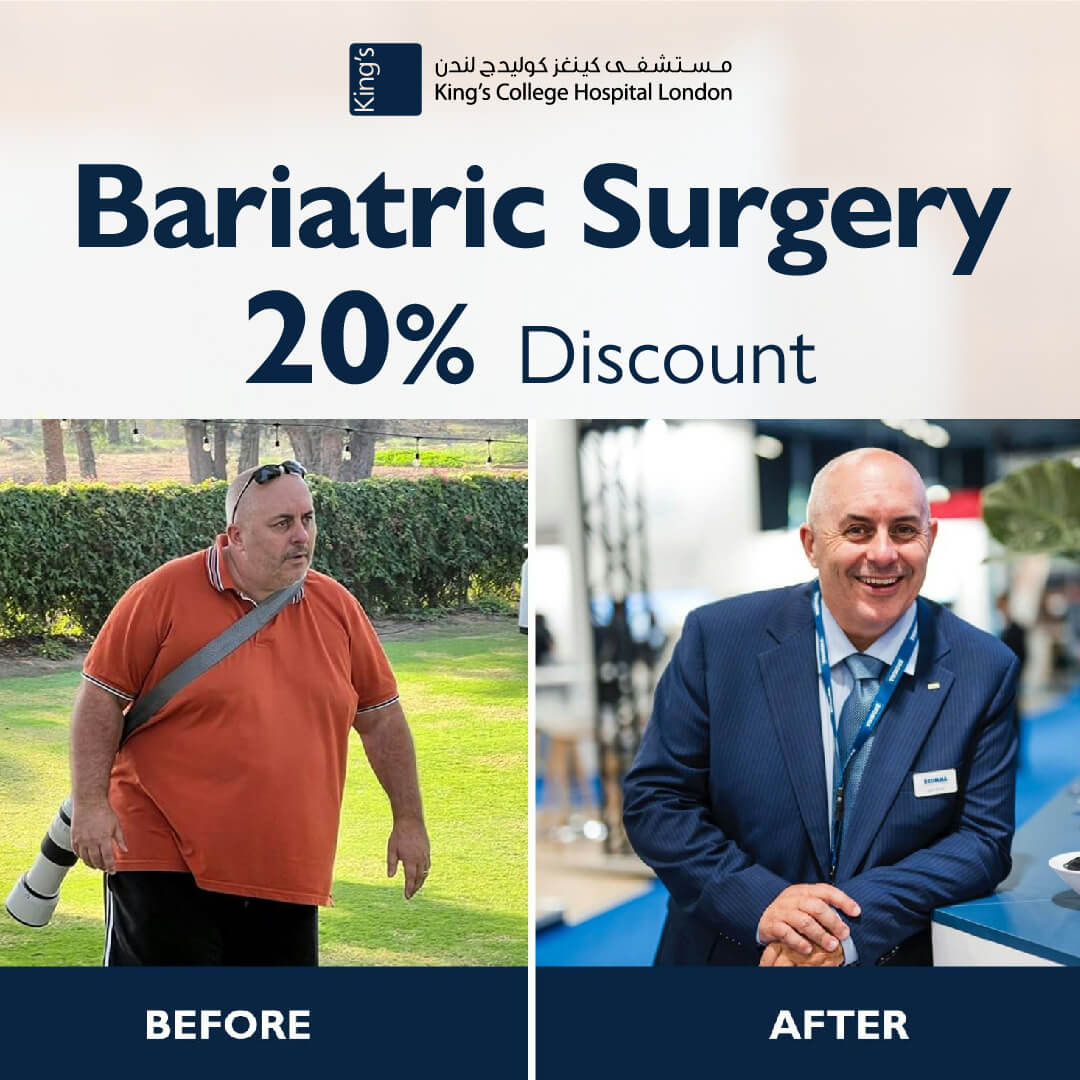What Is a Gastric Bypass Roux-en-Y?
A Gastric bypass Roux-en-Y is a type of weight-loss surgery that creates a new connection between a part of your stomach and part of the small intestine called the Roux limb, forming a “Y” shape. This way, the food you take will pass only through this new bypass.
At King’s we offer the Gastric Bypass procedure as part of our Weight Loss & Bariatric Programme. An optional 6 month support package post surgery can be availed, to ensure you have the best opportunity to reach your weight loss goals.

Why Is the Surgery Done?
Gastric bypass surgery is usually done to treat morbid obesity by restricting the amount of fat and calories absorbed from your diet. Typically, the procedure is applied in order to reduce the risk of potentially life-threatening weight-related health problems.
Who Is the Surgery Recommended?
Gastric bypass surgery is mostly recommended if you suffer from morbid obesity. Your doctor might decide if the procedure is beneficial for you or not. The following conditions are required to qualify for the procedure:
- BMI 40 or higher.
- Obesity-associated serious health problems.
- No history of gastrointestinal diseases.
- Commit to healthy lifestyle changes.
Benefits and Potential Results
The gastric bypass procedure can be a very effective long-term way to lose weight, depending on how much you change your lifestyle habits. Losing approximately 60% of your excess weight within two years can be possible.
Additionally, it may also improve some health conditions related to being overweight, including:
- Diabetes
- Hypertension
- Hyperlipidemia
- Heart diseases
- Sleep apnea
- Osteoarticular diseases
- Infertility
Risks
Although we use the lasted minimally invasive surgery techniques, a gastric bypass involves major surgery, and as with any major surgery there are some possible risks.
Some of the risks associated with the surgical procedure itself include:
- Bleeding.
- Blood clots.
- Breathing problems.
- Gastrointestinal leaks
Long term post-surgery complications may include:
- Malnutrition
- Dumping syndrome, which includes diarrhea, nausea or vomiting
- Gallstones
- Bowel obstruction
Your Doctor will clearly explain any risks, and the post-surgery procedures to ensure the possibilities of complications are reduced.
Before Surgery
In order to be selected as a valid candidate for the procedure, your doctor might require some lab tests. Also, you need to inform them about your regular medication (blood-thinning, hypertension or diabetes medication) since there will be some restrictions on which you can take, as well as what you can eat and drink before the procedure.
During Surgery
Gastric bypass is now performed as a minimally-invasive procedure done by a Bariatric doctor through a laparoscopic technique. The procedure involves the following steps:
- After making several small incisions in your stomach the surgeon will insert the laparoscopic instruments and cut across the top of your stomach and make a small pouch.
- Part of your small intestine is cut and sewed directly into the stomach pouch.
- Food now will pass directly to your small intestine, avoiding the absorption of fat and carbohydrates.
During the procedure, you will be sleeping under general anesthesia and monitored closely for any complication. The whole procedure will take a few hours.
After Surgery
Immediately after the procedure, you won’t be allowed to eat or drink for about 8 hours. After that, your diet will be gradually changing over liquid to solid and the amount of food will be changing as well. Since gastric bypass is major surgery, you may be at the hospital at least 3-5 days. Also, your doctor will recommend you take vitamin and mineral supplements after your surgery because of the malabsorption system created.
Should you have any further inquiries or require additional information, please feel free to reach out to our team at 0566855872

Faqs
الأسئلة الأكثر شيوعا
Roux-en-Y gastric bypass (RYGB) is a surgical procedure used to help people who struggle with obesity-related chronic conditions or those with a BMI of 35–40 or higher lose weight through restriction and malabsorption. It is frequently performed with robotics or as a laparoscopic surgery, with incisions made in the abdomen.
The goal of this surgery is to minimize the size of your upper stomach to a tiny pouch the size of a walnut. During the surgery, the upper section of your stomach is first separated from the lower portion and then connected to a section of your small intestine known as the Roux limb. This creates a «Y» shape. Your gastrointestinal system is then redirected to avoid the bigger portion of your stomach, limiting the number of nutrients and calories you absorb from the food you eat and the amount you can eat.
During the first year, to year and a half post-surgery, anticipate losing 70%-90% of your excess body weight.
If you follow dietary advice, you will lose more weight over the long term than with other treatments and more quickly than with the gastric band. Various weight-related health issues, such as diabetes, fatty liver disease, hypertension, hyperglycemia, and acid reflux, ameliorate and perhaps even heal, with some managing to cease medications for these ailments. It alters your metabolic system permanently to help you regulate your hunger, blood sugar, and blood pressure.
Yes, there are. Since your organs have been realigned, it will take you longer to recuperate and may feel more unpleasant compared to a gastric band procedure. You might have diarrhea and nausea as well as leaks, obstructions, and blood clots. Vitamin supplements will become a necessity for the remainder of your life, as the operation impairs your capacity to absorb needed calories and nutrients like iron, vitamin B12, and calcium.
The operation normally takes around 2 hours, but you will have to stay in the hospital for around 3 days. You will be able to resume your routine activities after around 2-3 weeks.
ЗАПИСАТЬСЯ НА ПРИЕМ
